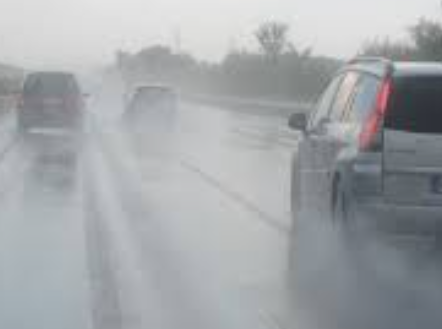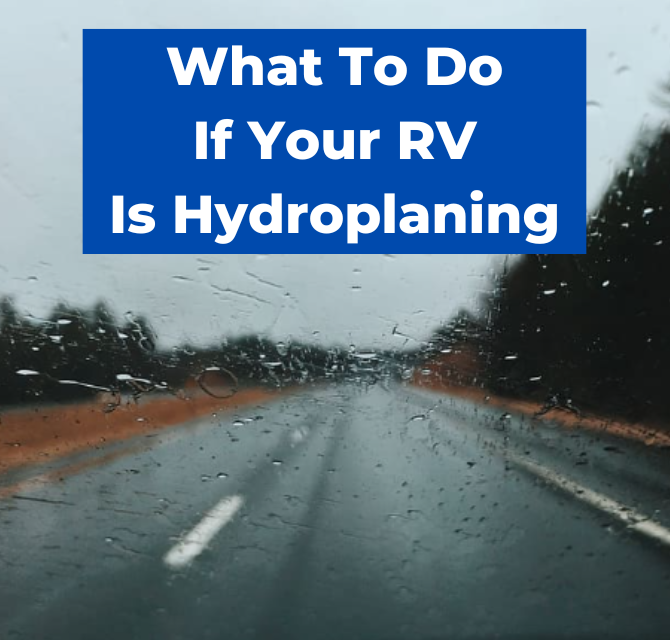When driving an RV in wet conditions, hydroplaning is a potential hazard that can occur when the vehicle’s tires lose contact with the road due to a layer of water. RV hydroplaning can cause the driver to lose control of the vehicle, leading to accidents and injuries. It is important to know what to do if your RV is hydroplaning to avoid accidents and keep everyone safe.
The first thing to do if your RV is hydroplaning is to stay calm. Panicking can cause the driver to make sudden movements that can make the situation worse. The driver should ease their foot off the gas and avoid sudden movements. The steering wheel should be kept straight, and sudden turns should be avoided. It is also important to avoid slamming on the brakes, as this can cause the vehicle to skid and lose control. Instead, the driver should gently pump the brakes to slow down.
We’ll go over everything you need to know about stopping and preventing hydroplaning from happening in your RV in this guide.
Understanding RV Hydroplaning

What is Hydroplaning?
Hydroplaning is a dangerous situation that can occur when your RV’s tires lose contact with the pavement and glide on top of a thin layer of water. This can happen when the tires encounter more water than they can displace, causing the vehicle to skid out of control. Hydroplaning can be terrifying and can happen suddenly, leaving the driver with little time to react.
Causes of Hydroplaning In Your RV
Hydroplaning can occur in any vehicle, but it is particularly dangerous in an RV due to its size and weight. Several factors can contribute to hydroplaning, including:
- Speed: The faster your RV is traveling, the more likely it is to hydroplane.
- Water: The amount of water on the road is a significant factor in hydroplaning. The more water on the road, the more likely your RV is to hydroplane.
- Tires: Worn or underinflated tires are more likely to hydroplane than properly inflated tires with good tread.
- Pavement: Smooth or worn pavement can increase the risk of hydroplaning.
- Vehicle weight: The heavier your RV is, the more likely it is to hydroplane.
How Hydroplaning Affects Your RV
When your RV hydroplanes, it can be challenging to maintain control of the vehicle. The driver may feel the vehicle start to skid and lose direction. The steering may become unresponsive, and the RV may veer off course. In some cases, the RV may spin out of control or even flip over.
To avoid hydroplaning in your RV, it is crucial to drive at a safe speed, maintain proper tire pressure and tread, and avoid driving through standing water. If you do find yourself hydroplaning, it is essential to remain calm and follow a few simple instructions to regain control of your vehicle.
Preventing RV Hydroplaning

Hydroplaning can be a scary experience for any driver, but it can be especially dangerous when driving an RV. Preventing RV hydroplaning should be a top priority for any RV owner. There are several steps you can take to prevent hydroplaning and ensure your safety on the road.
RV Driving Tips to Prevent Hydroplaning
One of the most important things to keep in mind when driving an RV is to slow down during rainy or wet conditions. This can help prevent hydroplaning by giving your vehicle better traction on the road. It’s also important to avoid using cruise control in wet conditions, as this can cause your RV to speed up unexpectedly and increase the risk of hydroplaning.
Maintaining a safe distance from other vehicles on the road is also important. This can give you more time to react if you start to hydroplane or if another driver loses control of their vehicle.
Maintenance Tips to Prevent Hydroplaning
Regular maintenance is essential for preventing hydroplaning. Maintaining proper tire tread is especially important, as worn tires can increase the risk of hydroplaning. RV owners should also make sure to check their oil levels regularly, as low oil levels can affect the performance of the vehicle’s anti-lock braking system.
It’s also important to make sure your RV’s steering wheel and brakes are in good working order. Pull over immediately if you notice any problems with your RV’s steering or brakes.
RV-Specific Tips to Prevent Hydroplaning
RV owners should also take steps to prevent hydroplaning that are specific to their vehicles. For example, it’s important to make sure your RV is properly weighted, as this can affect its stability on the road. Towing a travel trailer or other towable RV can also increase the risk of hydroplaning, so it’s important to take extra precautions when driving in wet conditions.
One way to prevent trailer sway and improve stability is to use an anti-lock braking system. RV owners should also make sure to plan a route that’s RV-safe, taking into account the weight and size of their vehicle.
See Related: How To Prevent RV Tire Dry Rot
Drive Slower In Rainy Or Wet Conditions
Driving slower in rainy or wet conditions can help prevent hydroplaning by giving your vehicle better traction on the road. It’s also important to avoid sudden stops or sharp turns, as these can cause your RV to lose traction and increase the risk of hydroplaning.
Don’t Use Cruise Control
Avoid using cruise control in wet conditions, as this can cause your RV to speed up unexpectedly and increase the risk of hydroplaning.
Plan A Route That’s RV-Safe
RV owners should make sure to plan a route that’s RV-safe, taking into account the weight and size of their vehicle. This can help prevent accidents and weather-related crashes by avoiding roads that are too narrow or winding for an RV.
Regular maintenance, proper driving techniques, and RV-specific precautions can all help prevent hydroplaning and keep you safe on the road. By following these tips, RV owners can enjoy their travels with peace of mind.
What To Do If Your RV is Hydroplaning
When driving an RV, encountering hydroplaning can be a scary experience. Hydroplaning happens when a layer of water builds up between the tires and the road surface, causing the vehicle to lose contact with the road and resulting in a loss of control. It can happen during heavy rains or at high speeds, especially in the middle lanes. Here are some steps to follow if you find yourself in this situation.
Here’s a good video that highlights some of the tips we’re about to share:
Stay Calm and Control Your RV
The first thing to do is to stay calm and avoid overreacting. When hydroplaning, the driver should keep a firm grip on the steering wheel and avoid sudden movements. It is important to maintain a straight course and not to brake or accelerate suddenly. The driver should also avoid turning the steering wheel abruptly, as this can cause the RV to skid.
Take Action to Regain Traction
To regain traction, the driver should gently steer in the direction of the skid to realign the tires, then steer in the other direction to straighten out the RV. If the RV has anti-lock brakes, the driver can brake as normal and the system will automatically pump the brakes to prevent the wheels from locking up. If not, the driver should ease off the gas pedal and gently pump the brakes to slow down.
React to the Situation
If the RV continues to hydroplane, the driver should reduce speed and avoid sudden movements. The driver should also avoid driving in the middle lanes, where water tends to accumulate. If sand is available, the driver can use it to improve traction by spreading it in front of the tires. However, the driver should avoid sudden movements when applying sand.
What To Do After Hydroplaning
After hydroplaning, the driver should check the tires for damage and ensure that the tread depth is adequate. The driver should also inspect the road surface for any hazards, such as debris or standing water. If the RV sustained any damage, the driver should contact their insurance company for advice.
In conclusion, encountering hydroplaning while driving an RV can be a frightening experience. However, by staying calm and following these steps, the driver can regain control and avoid accidents. Regular maintenance of the RV and tires can also help prevent hydroplaning in the first place.
See Related: How Long Do RV Tires Last?


